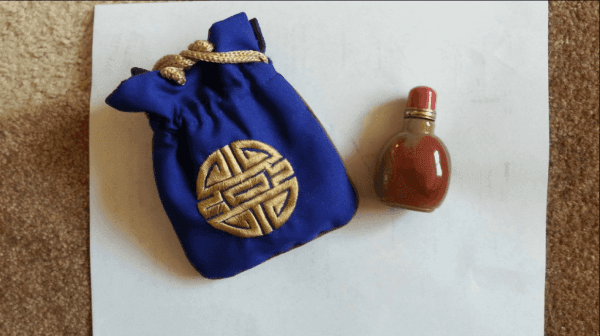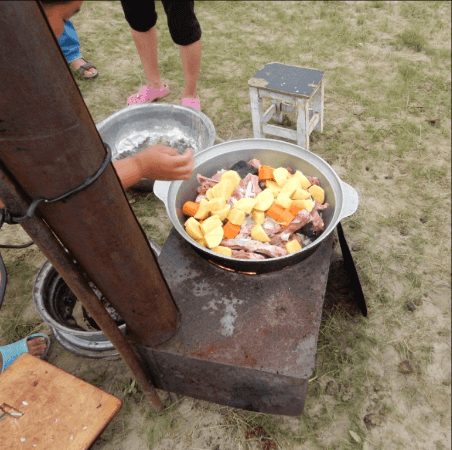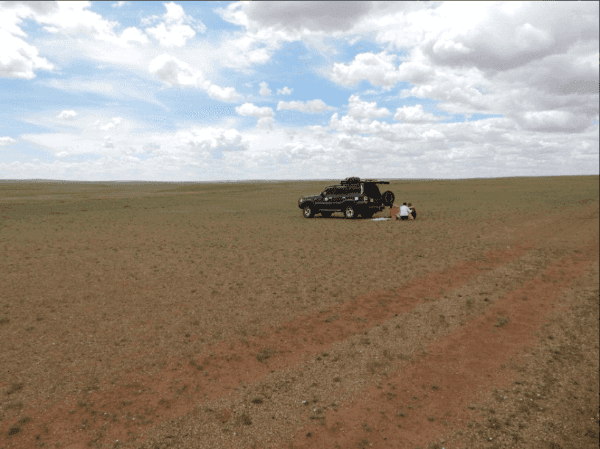Living the Nomadic Life in Mongolia
As we drove up to the three gers in the middle of the Gobi Desert, the nomadic family that lived there came out and greeted us: father, mother, two teenage sons and two daughters (ages 13 and 6). Mongolians have a reputation of being the most accommodating to strangers of any people on Earth, and this family was no exception. We were immediately invited into the middle ger.
We followed the pattern of a nomadic greeting used for centuries when both strangers and old friends happen to cross paths across the vast steppes and deserts of the huge and beautiful undeveloped landscape that makes up 95% of the country of Mongolia, and which is simply called the “countryside” by locals. Step 1 of the greeting is for the males to each take out their snuff bottles, take a brief snort, and then present it partially opened (always with their right arm supported at the elbow with their left hand) to each of the others for their sniffing enjoyment. Our driver, Munkhbat (or Moogie for short), and guide, Ulzi, had helped me select my own snuff bottle carved out of stone the day before . . . for just such an occasion. [side note: Moogie was making a living driving tourists, but he had a degree from the Mongolian University of Science and Technology and had worked in a coal mine for many years until being laid off a few years ago. As a miner, he worked 12 hours a day, ten days in a row, and then had five days off.]

With smelling each other’s scents out of the way, we moved on to the host wife’s offering of a series of her recent culinary creations. First up was a bowl of warm horse milk that we were each expected to sip and then pass to the next person for his or her enjoyment. I must admit that the thought of horse milk was far worse than the taste, and the warmth of the milk was probably more of a problem for me than the fact that it was from a horse rather than a cow, but I did drink my allotment. Incidentally, later in the day, the wife demonstrated for us how she milks the horses . I’m not sure why this seems so strange to me. After all, isn’t it just our upbringing that makes us believe that milking cows is somehow more natural? By the way, notice in the photo below how the husband holds the foal right in front of the mare while she is being milked by the wife. I suspect this is so the mare thinks she is nursing her foal, and everybody stays calm. Another fact worth noting: although I did not realize it at the time, my wife later informed me that the horse milk we were drinking was actually fermented, so its warmth was obviously from a fire, not from the horse.

Next on the menu was hot milk tea. I’m not a fan of tea, hot or cold, but this drink is much more like hot milk than it is like hot tea. I never found out what animal had produced this milk. Given that this family owned 70-100 horses, 300-500 sheep, 500-600 goats, and 200-300 cows, I guess it could have been any of these. Neighboring families were raising camels and yaks, so I guess it could have even been a camel or yak. We each received our own bowl of milk tea.
After the milk tea, another interesting drink was passed around in a community bowl. They called it vodka, but it was white in color and, once again, hot. I gather it was mostly a milk base with a small amount of vodka added. I took a quick sip when offered, but I don’t believe I saw anybody else in the room partake. In general, Mongolians believe that hot drinks keep you healthy and cold drinks don’t serve much purpose. The hotter it is outside the ger, the more that Mongolians crave hot drinks. I’ve witnessed this in other (mostly Asian) cultures before, but it isn’t my cup of tea. Personally, when I’m hot, I crave cold drinks. Mongolians think I’m nuts.
Various breads and yak curd were offered and then we all dispersed. The boys plus Moogie went out to break some horses. The girls retired to watch television; they had a diesel generator. The parents started cleaning up and getting ready for dinner. Ginny, Ulzi, and I went out to watch the horse breaking action.
While the mother and father were busy milking horses, the boys on horseback were breaking two of the horses in the herd. The same process was used for both horses. First, the horse was chased by the boys around the area repeatedly while they were trying to rope it. In the American West, I think this process occurs in an enclosure; in Mongolia it happens in the wide open spaces. We watched as the boys chased the horse in wide circles over an area of around a square mile. Instead of using a lasso, these boys were using a long pole with a rope loop at the end, designed to tighten when the loop snags the head of a horse and the pole is pulled in the opposite direction. As I watched, I couldn’t tell if the goal of the chasing was to tire out the horse or if the boys were actually trying to snag the horse with the pole. In any case, it took quite some time for the horse to finally be captured. Once captured, one boy would jump on the back of the horse (in the first case, a saddle was attached first; in the second case, no saddle was used) and hold on while the horse bucked and ran around like crazy trying to get rid of the unwanted weight on its back. In both cases, the horse and rider disappeared over the horizon only to reappear 20 minutes later led back by the other boy on his [already tamed] horse. I was exhausted just watching the process.

An hour later, we were called to the central fire to watch dinner being prepared. While father was tending the fire, mother was throwing potatoes, carrots, and mutton ribs into a large pot. Occasionally, father would remove a red hot rock with iron tongs from within the fire and place it into the pot along with the food. When the pot was full of food and rocks, it was covered and left to cook on the open fire.
When dinner was ready, the four guests got to eat their fill. The family ate only after the guests finished. Such is the standard of Mongolian hospitality.

I’ve always thought of nomads as people who constantly roam from place to place. The nomads of Mongolia, however, actually rotate between four homesteads during the year, ensuring that their livestock always have access the food and water. The land is not owned; in fact, there is so much undeveloped land, no conflicts arise among the thousands of nomadic families. All know exactly where they should go, where their seasonal homesteads are located, and where their livestock will graze. Winter homesteads are almost always located next to a hill or otherwise designed to be protected from harsh winter winds; these homesteads also include corrals to protect the most vulnerable livestock during bad weather. During the other seasons, gers are simply erected out in the open and livestock are free to roam.
Mongolians are big meat eaters. In general, vegetarian visitors have a difficult time finding enough to eat. All the animals being raised by the nomads are sources of meat: sheep, goats, horses, yaks, cows, and I guess even camel. I understand that horse is consumed only in the winter.
Only part of our visit to Mongolia was with the nomads. We also spent a week driving around the wide open spaces of southern and central Mongolia, encompassing parts of the Gobi Desert and the steppes. We drove approximately 1,500 miles over this vast area with no roads. Ginny and I envision this was likely what the American Southwest was like in the 1600’s before roads were built, only we had the advantage of a Toyota LandCruiser, instead of horses to get us across the harsh, unforgiving, but beautiful landscape. Here is a typical scene one day when we stopped for a picnic lunch.

As Moogie drove cross country, we regularly encountered herds of animals, usually horses, camels, sheep, or goats. As we’d approach, the animals would often start running. Now, I’m not talking about small herds. Sometimes, these herds numbered many hundreds, and they would not necessarily run away from the vehicle. Moogie would never slow his pace. Instead he simply steered off the track (the only real difference between the track we were driving on and the rest of the terrain was the color of the ground: the track was somewhat tanner) in the direction of the tail of the herd. And at full speed, 60-70 kph, the LandCruiser would seem to join the back of the herd and follow it until it crossed the track we had been on originally. Then Moogie would steer the Toyota back on the track and continue on our original path. As a passenger, I discovered that if my eyes were closed, I would not even notice these persistent side excursions.
In the United States, we learn that if we need a toilet while traveling, we can always stop at a fast-food restaurant or gas station and find a relatively clean toilet. We’ve traveled all over the World, so we are very comfortable using outhouses, but the pit toilets of Mongolia provided us with a new experience in two ways: first, they only had one or two walls, and second, outside of Ulaanbaatar, they were the only toilet facilities available in restaurants and gas stations. Here’s one at a local gas station. The views while using toilets in Mongolia are much better than while using the same in the US.

By the way, gas stations were located approximately 200-250 miles apart, so careful planning was necessary (for fueling, not necessarily for the toilets).
Every 50 miles or so throughout the area, ger camps have been set up by entrepreneurial Mongolians. These camps comprise 20-40 gers, each with 1-2 beds, a central dining facility and a central bathroom (with real toilets) and a shower facility, usually with hot water. These are the Mongolian equivalents of motels and are quite comfortable. In the center of each ger (see photo below) is a rope attached to a heavy rock, designed to keep the ger from blowing away in case of a strong wind.


As we traveled cross country, we would occasionally stop in unannounced at a nomadic family’s homestead. Once we stopped to purchase wool for Ginny. Another time we stopped to ask for directions; no road signs existed anywhere in the desert. Another time we stopped to watch a husband and wife repeatedly tie up heads of 30 goats in long alternating lines and proceed to milk them.

On one such occasion, we wanted to visit Tovkhon Khiid, a Buddhist monastery built atop a 7000’ mountain named Shiveet Ulaan. We had two choices: hike, which would take over three hours and the trail was extremely muddy, rocky, and infested with millions of biting flies; or rent four horses for Ginny, Ulzi, Moogie, and me. Renting horses seemed like the logical choice. It took about an hour to reach the monastery and it was well worth it. Absolutely beautiful views from atop the mountain. Then it was time to come down. We were about 80% of the way down and my horse lost its footing while heading downhill at perhaps a 15 degree angle. He had set both his forefeet into a mud hole just behind a huge rock. He knees collapsed. His head hit the ground. I flew over his head. I tucked my head down so I wouldn’t land on it and break my neck. I ended up landing with my full weight on my shoulder and tumbled over. There are no ambulances in this part of the World. In fact, if an ambulance existed, it would have taken it 2-3 days to get to the nearest hospital! We were in the middle of nowhere. When I finally got my wits about me, I wiggled my toes; then I wiggled my fingers. I had not broken my back. Then I got up, checked that the horse was okay (she was) and walked the rest of the way down the mountain. Three days later we got back to Ulaanbaatar for our flight back to the States. Once there, I went to the emergency room. “I fell off a horse in Mongolia” sounded like a tall story, but I guess they believed me. I had four broken ribs and an injured shoulder.
Finally, although the countryside of Mongolia provides a great experience for the adventurous spirit, the capital city of Ulaanbaatar would surprise most Americans. Unlike most Asian cities, UB looks just like a Western city. In fact, while driving around, you might even think you were in Denver. The primary difference is that well over half the vehicles on the road are Priuses. And the rest of the vehicles (like Denver) are SUVs and pickup trucks.
© Alan M. Davis
If you enjoyed this story, consider buying my book,
Unusual Asia: Traveling on the Edge. It contains this and ten other stories of our adventures in Asia.